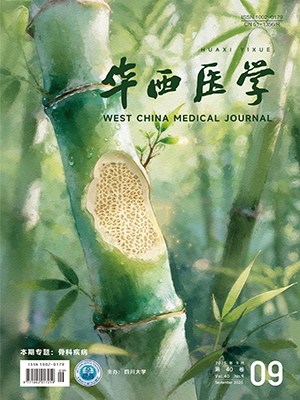| 1. |
Singer M, Deutschman CS, Seymour CW, et al. The third international consensus definitions for sepsis and septic shock (sepsis-3). JAMA, 2016, 315(8): 801-810.
|
| 2. |
Dellinger RP, Levy MM, Rhodes A, et al. Surviving sepsis campaign: international guidelines for management of severe sepsis and septic shock: 2012. Crit Care Med, 2013, 41(2): 580-637.
|
| 3. |
Huang CT, Tsai YJ, Tsai PR, et al. Severe sepsis and septic shock: timing of septic shock onset matters. Shock, 2016, 45(5): 518-524.
|
| 4. |
Shin TG, Jo IJ, Hwang SY, et al. Comprehensive interpretation of central venous oxygen saturation and blood lactate levels during resuscitation of patients with severe sepsis and septic shock in the emergency department. Shock, 2016, 45(1): 4-9.
|
| 5. |
Seymour CW, Liu VX, Iwashyna TJ, et al. Assessment of clinical criteria for sepsis: for the third international consensus definitions for sepsis and septic shock (sepsis-3). JAMA, 2016, 315(8): 762-774.
|
| 6. |
Dorsett M, Kroll M, Smith CS, et al. qSOFA has poor sensitivity for prehospital identification of severe sepsis and septic shock. Prehosp Emerg Care, 2017, 25: 1-9.
|
| 7. |
Raith EP, Udy AA, Bailey M, et al. Prognostic accuracy of the SOFA score, SIRS criteria, and qSOFA score for in-hospital mortality among adults with suspected infection admitted to the intensive care unit. JAMA, 2017, 317(3): 290-300.
|
| 8. |
Levy MM, Fink MP, Marshall JC, et al. 2001 SCCM/ESICM/ACCP/ATS/SIS international sepsis definition conference. Crit Care Med, 2003, 31(4): 1250-1256.
|
| 9. |
Ghanem-Zoubi NO, Vardi M, Laor A, et al. Assessment of disease-severity scoring systems for patients with sepsis in general internal medicine departments. Crit Care, 2011, 15(2): R95.
|
| 10. |
Giamarellos-Bourboulis EJ, Norrby-Teglund A, Mylona V, et al. Risk assessment in sepsis: a new prognostication rule by APACHEⅡ score and serum soluble urokinase plasminogen activator receptor. Crit Care, 2012, 16(4): R149.
|
| 11. |
Lagu T, Rothberg MB, Shieh MS, et al. Hospitalizations, costs, and outcomes of severe sepsis in the United States 2003 to 2007. Crit Care Med, 2012, 40(3): 754-761.
|
| 12. |
Rhodes A, Evans LE, Alhazzani W, et al. Surviving sepsis campaign: international guidelines for management of sepsis and septic shock: 2016. Crit Care Med, 2017, 45(3): 486-552.
|
| 13. |
Talan DA, Moran GJ, Abrahamian FM. Severe sepsis and septic shock in the emergency department. Infect Dis Clin North Am, 2008, 22(1): 1-31.
|
| 14. |
Donnelly JP, Safford MM, Shapiro NI, et al. Application of the third international consensus definitions for sepsis (sepsis-3) classification: a retrospective population-based cohort study. Lancet Infect Dis, 2017: S1473-3099(17)30117-2.
|
| 15. |
Wang JY, Chen YX, Guo SB, et al. Predictive performance of quick sepsis-related organ failure assessment for mortality and ICU admission in patients with infection at the ED. Am J Emerg Med, 2016, 34(9): 1788-1793.
|
| 16. |
Vincent JL, Moreno R, Takala J, et al. The SOFA (sepsis related organ failure assessment) score to describe organ dysfuntion/failure. On behalf of the working group on sepsis-related problems of the european society of intensive care medicine. Intensive Care Med, 1996, 22(7): 707-710.
|
| 17. |
Cecconi M, De Backer D, Antonelli M, et al. Consensus on circulatory shock and hemodynamic monitoring. Task force of the european society of intensive care medicine. Intensive Care Med, 2014, 40(12): 1795-1815.
|
| 18. |
Kellum JA, Song M, Subramanian S. Acidemia: good, bad or inconsequential?. Vincent//JL, 2002: 510-516.
|
| 19. |
Kellum JA. Metabolic acidosis in patients with sepsis: epiphenomenon or part of the pathophysiology?. Crit Care Resusc, 2004, 6(3): 197-203.
|
| 20. |
Jansen TC, van Bommel J, Schoonderbeek FJ, et al. Early lactate-guided therapy in intensive care unit patients: a multicenter, open-label, randomized controlled trial. Am J Respir Crit Care Med, 2010, 182(6): 752-761.
|
| 21. |
Jones AE, Shapiro NI, Trzeciak S, et al. Lactate clearance vs central venous oxygen saturation as goals of early sepsis therapy: a randomized clinical trial. JAMA, 2010, 303(8): 739-746.
|
| 22. |
呂曉春, 許強宏, 蔡國龍, 等. ScVO2 聯合乳酸清除率指導膿毒癥休克患者的容量復蘇. 中華醫學雜志, 2015, 95(7): 496-500.
|
| 23. |
田煥煥, 韓沙沙, 呂長俊, 等. 早期目標乳酸清除率對肺部感染致膿毒性休克治療的作用. 中華危重病急救醫學, 2012, 24(1): 42-45.
|
| 24. |
于斌, 田慧艷, 胡振杰, 等. 乳酸清除率和中心靜脈血氧飽和度指導嚴重感染患者液體復蘇效果的比較. 中華危重病急救醫學, 2013, 25(10): 578-583.
|
| 25. |
Gu WJ, Zhang ZH, Bakker J. Early lactate clearance-guided therapy in patients with sepsis: a meta-analysis with trial sequential analysis of randomized controlled trials. Intensive Care Med, 2015, 41(10): 1862-1863.
|
| 26. |
Simpson SQ, Gaines M, Hussein Y, et al. Early goal-directed therapy for severe sepsis and septic shock: a living systematic review. J Crit Care, 2016, 36: 43-48.
|
| 27. |
Kimmoun A, Novy E, Auchet T, et al. Hemodynamic consequences of severe lactic acidosis in shock states: from bench to bedside. Crit Care, 2015, 19: 175.
|
| 28. |
Wacker C, Prkno A, Brunkhorst FM, et al. Procalcitonin as a diagnostic marker for sepsis: a systematic review and meta-analysis. Lancet Infect Dis, 2013, 13(5): 426-435.
|
| 29. |
Azevedo JR, Torres OJ, Czeczko NG, et al. Procalcitonin as a prognostic biomarker of severe sepsis and septic shock. Rev Col Bras Cir, 2012, 39(6): 456-461.
|
| 30. |
De Jong E, Van Oers JA, Beishuizen A, et al. Efficacy and safety of procalcitonin guidance in reducing the duration of antibiotic treatment in critically ill patients: a randomised, controlled, open-label trial. Lancet Infect Dis, 2016, 16(7): 819-827.
|




